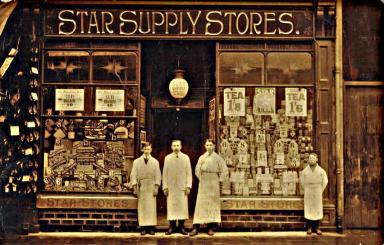Murder At The Star - An Interview With Steve Adams
Back to Welsh Literature page >
AmeriCymru spoke to Steve Adams. Steve is a journalist currently researching the unsolved 1921 murder of shopkeeper Thomas Thomas at Star Stores in the Carmarthenshire village of Garnant.
Follow his progress on his blog:-
...
AmeriCymru: Hi Steve and diolch for agreeing to this interview. When did you first become interested in the murder of Thomas Thomas?
Steve: As chief reporter of the South Wales Guardian, the Ammanford-based weekly newspaper, I’m always on the look-out for stories with an Amman Valley link, particularly those which allow me to explore two of my other great interests – Welsh history and historic crime. So, when in the spring of 2013 I came across the essay A Long Time between Murders by the globally-renowned international affairs expert Owen Harries, my heart skipped a beat.
Mr Harries was born in the Amman valley in the early 1930s and his 2001 essay compared life in Washington DC – where he was then living and where a dozen murders in a weekend was not uncommon – to his childhood in rural Wales. In his home village of Garnant the unsolved 1921 murder of a shopkeeper remained the only major crime for more than 70 years until the owner of a local restaurant discovered his wife had taken a fancy to more than just the new chef’s fruity desserts. However, it was the murder of the half-deaf bible-quoting shopkeeper that kept returning to my mind, not least because although the case remained officially unsolved, the valley rumour mill had long since been pointing the finger.
The more I looked into the killing of Thomas Thomas at the Star Stores, the more engrossed I became. The more details I uncovered, the more the story read like an Agatha Christie novel – and by a strange quirk of fate, the murder at the Star was actually committed just 23 days after the UK release of Christie’s first book. The killing of Thomas Thomas had all the ingredients of a great Whodunnit?
A shopkeeper killed in a locked shop; three separate wounds all of which was enough to prove fatal; a lump of cheese used as a gag; Scotland Yard detectives; the takings stolen; and a host of characters and suspects lifted straight from the pages of a Dickens novel. And while the tale of the murder was in itself a great albeit unknown story, I could also see there was something far larger bubbling away in the background. It seemed to me that the murder at the Star also told the story of south Wales and its transformation from rural society to industrial boom, and then the inevitable, painful decline.
AmeriCymru: Care to describe the Amman valley for the benefit of our readers? What kind of community was it at the time the crime was committed?
Steve: One of the most intriguing aspects of the murder at Star Stores was how – to my mind at least - it symbolised the changing nature of south Wales from the middle of the 19th century to the years immediately after the Great War. In less than a single lifetime, the valley, which at the time Victoria came to the throne was known as Cwmaman and was nothing more than a scattering of farmsteads, exploded into life.

Commerce Place Garnant
The discovery of coal saw the birth of a hamlet which in turn grew so quickly that it soon swelled and split into two separate villages, Garnant and Glanaman. Between them they boasted two train stations, numerous mines, factories, tin-plate works, and scores of shops, including national chains such as the Star. Glanaman had a dedicated sheet-music shop, while Garnant offered at least three hat shops. There were stationery shops, banks, hairdressers, pubs, greengrocers, cabinet makers and confectioners – all desperate to relieve the miners of their weekly wage.
In little more than 50 years, the area went from a population which barely reached three figures to being home to around 20,000 people. Such was the relentless growth of the villages that demand for lodgings far outstripped supply and Thomas Thomas rented not a room, nor even a bed, but a share of a bed. The war years were undoubtedly a boom time for mining communities as the thirst for coal to fuel the war effort became unquenchable and people came from far and wide to share the wealth.
The demand for workers grew and grew, but by the early 1920s things had begun to change. As the demand for coal begin to fall so the wealth that fed the boom of Garnant and Glanaman faltered and its disappearance marked the arrival of something new – crime. In the case of Thomas Thomas, it culminated in the worst of crimes – murder.
AmeriCymru: The murder went unsolved at the time but the locals had a theory concerning the identity of the culprit. Care to tell us more?
Steve: Within days of the crime being committed a number of names began circulating around the village – and further along the valley – as likely suspects, each with the means, the motive and the opportunity to kill.
Some thought the killer was Thomas Thomas’ landlord, asking why he had not raised the alarm when his lodger failed to return home that night; some believed it was the property developer who had built the store on land leased from Baron Dynevor, the local landowner – a costly 20-year legal dispute culminated in a High Court appearance and all but bankrupted the Garnant man who was left desperately short of cash and with bills to pay; others believed it was the local ne’er-do-well, a man who served time behind bars in his youth and who had lost his hand just six months prior to the murder in a suspicious explosion for which he offered police only the most bizarre of explanations.
There were also rumours of illicit love affairs, jealousy and vengeance. Local suspicion reached fever-pitch until the day of Thomas Thomas’ funeral when the dead man’s brother was approached by a mysterious stranger who put a name to the killer.
The informant has never been identified, but the name he gave remains in the village consciousness to this day as the man who killed Thomas Thomas. In fact, I was contacted by a lady in her 80s less than a month ago and told in no uncertain terms that the man named at the funeral was indeed the killer. The rumour and gossip has become more entrenched with each passing decade.
AmeriCymru: I know from our previous discussions that you have your own theory, indeed perhaps more than a theory about the perpetrators identity. Can you tell us more without giving too much away?

In many respects, the investigation into the murder at the Star became less a question of who the evidence pointed to and more who it eliminated as a suspect. Sherlock Holmes’ famous adage that “when you have eliminated the impossible, whatever remains, however improbable, must be the truth” became the basis for the entire investigation. In Holmes’ cases, the logic worked perfectly well because the great fictional detective never missed or misunderstood a clue. Sadly, real life is never so clear cut.
Vital evidence was misinterpreted during the days of the investigation at the Star, clouding the entire inquiry and causing the police to eliminate the real killer. Having been able to reassess the evidence and show what I have collected to modern-day experts in their field, I am confident I can prove that not only were the police wrong to remove one of the suspects from their inquiry when they did, but rather than eliminate him, the evidence proves he was only man in Garnant capable of committing the murder in the manner that he did.
AmeriCymru: You are publishing a book about the case soon. When will it be available for purchase online?
Steve: I am in the process of writing a book on the case and I am currently in discussions with a publisher to secure a book deal. I’d rather not go into the specifics just yet, but I’m optimistic we will be able to thrash out a deal in the coming weeks.
The book will of course be available from all the usual online outlets and as an e-book, although I am still some way away from completing the finished product. In the meantime I am continuing to write a blog on the case, which can be found on Americymru.net and at www.murderatthestar.wordpress.com where readers are able to follow the progress of the book in rough draft form. In fact, it is due to the numbers of people who have been reading the blog and contacting me through social media that I contacted the publishing company when I did.
What began as something of a pet project and a labour of love quickly gathered a substantial following and I have been overwhelmed by the interest – from Amman valley residents, those who were born in the area but have since moved away and readers simply interested in a cracking yarn.
AmeriCymru: Any final message for the readers and members of AmeriCymru?
Steve: I would just like to thank everyone on Americymru who has read the blog – either on the Americymru site or via the Murder at the Star blog. I never really imagined the murder at the Star would be of any interest to anyone apart from me – how wrong I was. It is only due to the support and encouragement of the readers that I continued digging away until I reached the point when I became confident enough to say I have solved the murder at the Star.
















